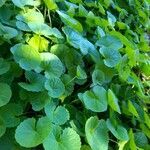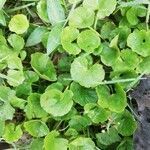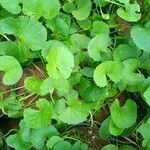Procumbent perennial herb, with a slender to stout taproot, rooting at the nodes, up to at least 1 m. in length but often less. Stem terete, finely striate, green or suffused purplish. Leaves solitary or in groups of up to 6 on very short lateral shoots, thin to more commonly rather leathery in texture, very variable in size, separated by long slender internodes up to as much as 16 cm long, the lamina roundish to reniform with a narrow to very wide basal sinus, ±0.8-9 cm wide and 0.8-5.5 cm long from apex to petiole, ± regularly bluntly crenate or the teeth sharply mucronate all round or towards the base, palmately nerved with the nerves branched at ± halfway to the margin, secondary venation increasingly faint, surfaces glabrous or very faintly pilose; sheaths narrowly oblong, ±3-12 mm, striate, membranous margined; petiole very variable in length, 3 mm to 30 cm, glabrous or more commonly softly white-pilose at least below the lamina. Umbels subcapitate, 1-5 together on slender, thinly to densely pilose peduncles 3 mm to 4 cm long, which ± reflex in fruit. Flowers 1-7 in each umbel; pedicels very short (at most 1.5 mm) and pilose, or obsolete; involucre of 2 broadly ovate, membranous-margined bracts 1.5-5 mm long. Petals roundish to broadly obovate, ±1 mm, greenish to purplish red, often with minute whitish hairs on the central dorsal surface. Fruit very strongly laterally compressed, oblate-rounded, ±3-4 mm, glabrous or with fine, rather long white hairs; primary and secondary ribs narrowly prominent, with ± anastomosing veins between; stylopodia low and rounded, finally indistinct; styles ± divergent, ±0.5-0.75 mm.
A slender perennial plant with creeping stems which root at the nodes. It grows to 10 cm high and spreads to 50 cm across. The stems are creeping and form roots at the nodes. Groups of leaves develop in clumps at the nodes. Leaves are round or heart shaped with a wavy edge. The edge has teeth or indentations along it. The leaves can be 8 cm across, when grown in shady places. The leaves have 7-9 forked veins. The leaf stalks are 6-15 cm long. The stems and flowers are dull red or pink. The flowers are small and occur in small clusters. The fruit is round but flattened. It is very small and 2 mm across.
Stems creeping with long stolons, more or less puberulous in the young state. Leaves in rosettes; petioles 1-40 cm, sometimes puberulous; lamina 1-7 cm diam., roundly reniform, crenate or crenate-dentate. Umbels solitary or 2-5 together in the axils of nearly 3 mm long bracts; peduncles ½-5 cm, shorter than the petioles. Flowers usually 3, middle one sessile, lateral ones pedicellate; involucres 2, 3-4 by nearly 1½ mm, ovate. Petals red, 1-1½ by ¾ mm. Mericarpsabout2 by 1½ mm, subhairy when young.
Petiole 0.5–10(–30) cm; leaf blade orbicular or reniform, 1–4.5 × 1.5–5 cm, palmate veins 5–7, prominent, both surfaces glabrous or abaxially sparsely pubescent on the veins, base broadly cordate, coarsely toothed. Peduncles 2–4, clustered axillary, 0.2–1.5 cm; bracts 2 (rarely 3), ovate, 3–4 × 2.1–3 mm, persistent in fruit; umbels 3–4-flowered, capitate. Flowers sessile or subsessile. Petals white or rose-tinged. Fruit 2.1–3 × 2.2–3.6 mm. Fl. and fr. Apr–Oct.
Perennial herb; stems procumbent. Flowering stems up to 0.13 m high; erect. Leaves simple, long petiolate; blade reniform to orbicular, base deeply heart-shaped, margins with teeth thickened, glabrous below, occasionally thinly pilose. Flowers: in small umbels near surface of soil; partly enclosed in 2 green bracts; dark crimson to greenish white; Sep.-May. Fruit laterally compressed, densely reticulate.
Prostrate perennial, spreading with stolons and rooting at nodes. Leaves petiolate, reniform to rounded, sparsely hairy to glabrous, margins regularly crenate all round. Inflorescences: umbels simple, axillary. Flowers bisexual, 3 per umbel. Petals greenish to purplish red. Flowering time Nov.-Mar. Fruit strongly laterally compressed, obovate, longer than bracts, wrinkled.
Flowers 2–8, hermaphrodite, with an involucre of 2 ovate, membranous, persistent bracts. Pedicels slender or obsolete; petals dark crimson to greenish-white, orbicular with a slender inflexed point. Calyx teeth and stylopodium obsolete; styles short, ± divergent.
Leaves solitary or in groups of up to 5, pubescent or glabrous; lamina 1–7 cm. wide, reniform to almost orbicular, with a deep basal sinus; margin crenate, glabrous or with scattered hairs on upper part of petiole (petiole sometimes densely hairy when young).
Prostrate perennial, spreading with stolons and rooting at nodes. Leaves petiolate, kidney-shaped to rounded, sparsely hairy to glabrous, crenate. Flowers bisexual, 3 per umbel, reddish. Fruit obovate, longer than bracts, wrinkled.
Creeping herb. Leaves reniform to orbicular with distinct basal sinus; papery, as broad as long or broader than long, often glabrous below, occasionally thinly pilose. Flowers dark crimson to greenish white.
Fruit 3·5× 3 mm., orbicular to ellipsoid, brown at maturity, deeply constricted at the commissure and flattened laterally, primary ribs prominent when ripe, secondary ribs ± evident; carpophore entire.
Umbels subcapitate; peduncles 1·5–5 cm. long, glabrous or pubescent, usually much shorter than the subtending petiole.
Creeping herb, rooting at the nodes, but sometimes forming a large taproot.
Stem terete, with shallow grooves, sometimes purplish.
A perennial creeping plant, rooting at the nodes
Flowers purplish




